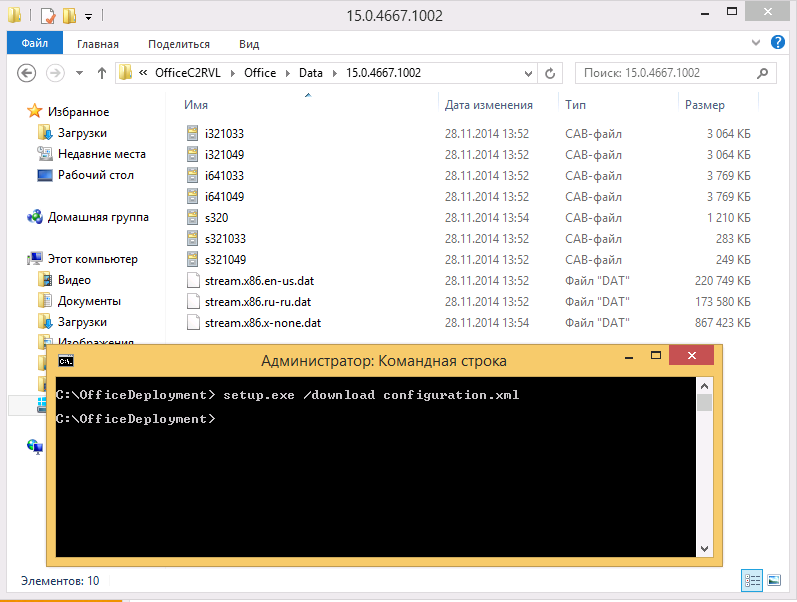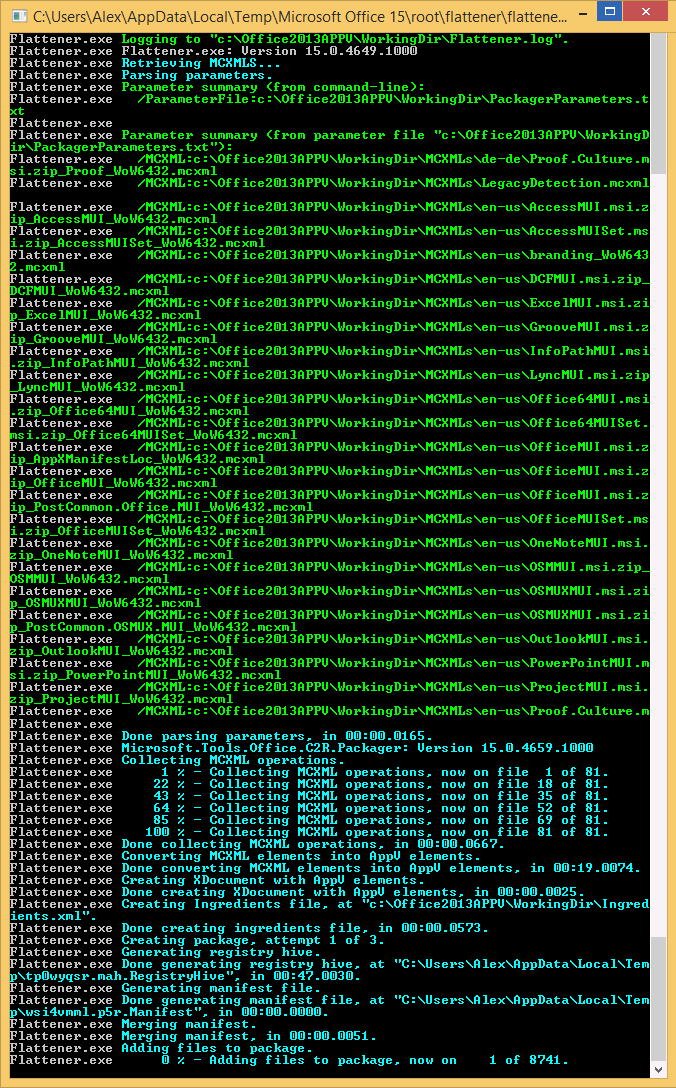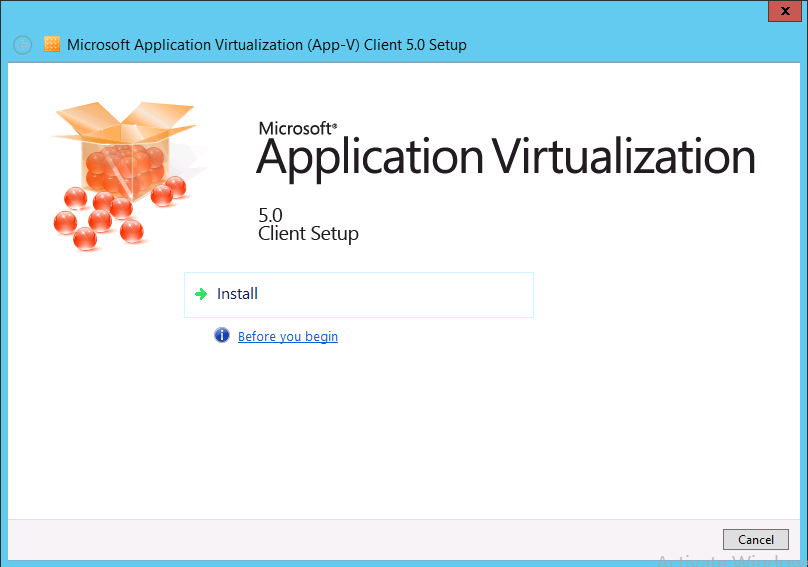How to download virtual corporate Office 2013 from Microsoft
I want to share the scenario of working with Microsoft Office applications, which does not require any search for a distribution kit, installation of a package, or an update. For several years, Office2 subscribers have been offering the Click2Run version of the office suite, which downloads, in fact, an already installed Office with the latest updates. The unpleasant moment is that the Click2Run version is distributed only in the Retail version, which requires a special key and manual activation, or an Office365 subscription. However, something influenced the company’s policy, and without much pomposity, the Volume 2013 (corporate) version of Office 2013, which is activated by your KMS server, or other activation method, and which cannot be used as Click2Run, can be converted into special downloads. into APP-V virtual application 5.0. Now I will talk about how to legally download the full set of installed and updated Microsoft Office products, and how best to use it without clogging up the system. If there is interest, I will later talk about a similar scenario for a newer version of Office, which is currently in beta testing, how to get updated builds first-hand and use them without interfering with our local stable versions of the product.
The first tool we need to download Office 2013 from Microsoft servers is the Office Deployment Tool . Download and install on a machine with fast internet. The installer will extract two files: setup.exe and configuration.xml. It is the last file of particular interest to us. In the default file, the English Retail versions of Office and Visio are offered as an example, which means that they will need to be activated by phone or internet, which few people want to do. In order to download the Volume version of Office products, you need to replace the value of the Product ID field, and to download the Russian version, the value of the Language ID field. Personally, I am a supporter of products with the English interface, but I consider Russian spelling for Office as mandatory. Since I consider myself lazy, and I don’t even want to re-create the package in Russian, I will immediately select all three possible product volumes and two languages at once - Russian and English. This will automatically download the Russian and Ukrainian Proofing Tools, and allow me to select the product interface language from the Office 2013 Language Preferences menu (by default it matches the OS interface language - in Russian, Windows will be Russian Office, in English Windows - English Office). In the configuration.xml example I’m giving, I choose the 32-bit version of Office — your right to change this to 64.
After saving such a file, I will launch the command line, go to the folder where I unpacked the Office Deployment Tool, and where I edited the configuration.xml and execute the command:

')
Within a few minutes (depending on the speed of your Internet connection), the Click2Run corporate version files Office, Visio and Project for the Russian and English interfaces will be loaded into the folder specified in the xml file. Build Office - the latest. Today (end of November 2014) build 15.0.4667.1002 is being downloaded. A trivial search for these numbers leads me to the November 2014 Office Update Release page, that is, I get Office with the latest built-in security updates. It remains only to learn how to run what we downloaded, because there is a set of CAB files, and not a single executable module. If we downloaded the Retail version of the package, then the same Office Deployment Tool would help us install Click2Run for use without further action, simply by running the command:

In order to take advantage of this treasure, we will need to install the client APP-V 5.0 SP3 . APP-V is part of the Microsoft Desktop Optimization Pack, and part of RDS CAL, - those companies that have Windows Software Assurance or use Microsoft terminal solutions have already paid ($ 10 per year) for APP-V. Download in this case from the MSND / TechNet or Volume Licensing sites. Keywords: mu_application_virtualization_hosting_for_desktops_5.0_service_pack_3 and mu_microsoft_desktop_optimization_pack_2014_r2_x86_x64_dvd_5994499.iso. There are many alternative ways to find what you need on the Internet. Install the client APP-V 5.0 SP3 by running APPV_CLIENT_SETUP.EXE (APPV_CLIENT_SETUP_RDS.EXE if we are talking about a terminal server). I also recommend installing the latest update; the list is available at http://support.microsoft.com/kb/2940578 . Things are easy, make the virtual office work.

Since actions on APP-V packets in the Stand-alone case (without an APP-V server) are performed from PowerShell, we will launch it in administrator mode, disable the requirement for signed modules:

We can only publish this virtual package, indicating your PackageID and VersionID. I publish globally - for all PC users, including non-domain users with the command:

Immediately applications are available for use:

When you first start the application is cached, there is a progress slider for 20-30 seconds:

Now we have full Office 2013 with Visio and Project on our PC. Activation status - 30 days standby:

Now, using your corporate KMS server or other activation methods, activate the Volume version of Office 2013 products and start using it.
In general, APP-V allows you to place this package on a file server and publish an office for all client PCs, without requiring any action on their side through the APP-V Server. Unfortunately, application virtualization technology is little propagandized by Microsoft - in view of the fact that all companies have already paid for it anyway - there is no point in putting efforts into promotion. But the technology is extremely interesting, and in conjunction with terminal solutions and application publishing by means of RemoteApp, it allows you to build really beautiful architectures. You can talk about this another time.
The first tool we need to download Office 2013 from Microsoft servers is the Office Deployment Tool . Download and install on a machine with fast internet. The installer will extract two files: setup.exe and configuration.xml. It is the last file of particular interest to us. In the default file, the English Retail versions of Office and Visio are offered as an example, which means that they will need to be activated by phone or internet, which few people want to do. In order to download the Volume version of Office products, you need to replace the value of the Product ID field, and to download the Russian version, the value of the Language ID field. Personally, I am a supporter of products with the English interface, but I consider Russian spelling for Office as mandatory. Since I consider myself lazy, and I don’t even want to re-create the package in Russian, I will immediately select all three possible product volumes and two languages at once - Russian and English. This will automatically download the Russian and Ukrainian Proofing Tools, and allow me to select the product interface language from the Office 2013 Language Preferences menu (by default it matches the OS interface language - in Russian, Windows will be Russian Office, in English Windows - English Office). In the configuration.xml example I’m giving, I choose the 32-bit version of Office — your right to change this to 64.
<Configuration> <Add SourcePath="C:\OfficeC2RVL" OfficeClientEdition="32" > <Product ID="ProPlusVolume"> <Language ID="en-us" /> <Language ID="ru-ru" /> </Product> <Product ID="VisioProVolume"> <Language ID="en-us" /> <Language ID="ru-ru" /> </Product> <Product ID="ProjectProVolume"> <Language ID="en-us" /> <Language ID="ru-ru" /> </Product> </Add> </Configuration> After saving such a file, I will launch the command line, go to the folder where I unpacked the Office Deployment Tool, and where I edited the configuration.xml and execute the command:
setup.exe /download configuration.xml 
')
Within a few minutes (depending on the speed of your Internet connection), the Click2Run corporate version files Office, Visio and Project for the Russian and English interfaces will be loaded into the folder specified in the xml file. Build Office - the latest. Today (end of November 2014) build 15.0.4667.1002 is being downloaded. A trivial search for these numbers leads me to the November 2014 Office Update Release page, that is, I get Office with the latest built-in security updates. It remains only to learn how to run what we downloaded, because there is a set of CAB files, and not a single executable module. If we downloaded the Retail version of the package, then the same Office Deployment Tool would help us install Click2Run for use without further action, simply by running the command:
setup.exe /configure configuration.xml However, corporate versions do not yet allow Microsoft to use them. Instead, using the same Office Deployment Tool, I will convert the downloaded package into the Microsoft APP-V 5.0 package in order to use it without a trace on my PC, and be able to replace it with a newer version without reinstallation at any time. To do this, I need to run the command: setup.exe /packager configuration.xml c:\OfficeAPPV It does not work quickly, but it will convert the downloaded package to the APP-V 5.0 format. I would recommend performing this conversion on a PC (or virtual machine) where Office 2013 is not installed.
In order to take advantage of this treasure, we will need to install the client APP-V 5.0 SP3 . APP-V is part of the Microsoft Desktop Optimization Pack, and part of RDS CAL, - those companies that have Windows Software Assurance or use Microsoft terminal solutions have already paid ($ 10 per year) for APP-V. Download in this case from the MSND / TechNet or Volume Licensing sites. Keywords: mu_application_virtualization_hosting_for_desktops_5.0_service_pack_3 and mu_microsoft_desktop_optimization_pack_2014_r2_x86_x64_dvd_5994499.iso. There are many alternative ways to find what you need on the Internet. Install the client APP-V 5.0 SP3 by running APPV_CLIENT_SETUP.EXE (APPV_CLIENT_SETUP_RDS.EXE if we are talking about a terminal server). I also recommend installing the latest update; the list is available at http://support.microsoft.com/kb/2940578 . Things are easy, make the virtual office work.

Since actions on APP-V packets in the Stand-alone case (without an APP-V server) are performed from PowerShell, we will launch it in administrator mode, disable the requirement for signed modules:
Set-ExecutionPolicy –ExecutionPolicy Bypass -Force and import the module: Import-Module AppVClient The virtual package with Office 2013 contains scripts that install the Office Activation Service, and the execution of scripts is disabled by default in APP-V 5.0, so that we will force them to be executed: Set-AppvClientConfiguration -EnablePackageScripts 1 Now we import the package itself from Office, which we prepared earlier: Add-AppvClientPackage \OfficeAPPV\AppVPackages\VisioProVolume_ProPlusVolume_ProjectProVolume_en-us_ru-ru_x86.appv The result of executing the cmdlet will be a registered package, for which we will be given the PackageID and VersionID values (technically, the version of the package can be seen in DeploymentConfig.xml, created by the utility along with the package).
We can only publish this virtual package, indicating your PackageID and VersionID. I publish globally - for all PC users, including non-domain users with the command:
Publish-AppvClientPackage -PackageId d24c3bdd-8fad-44d3-998c-933f8f053682 -VersionId 374d4bd5-2866-4d4b-952b-3cade04f403a –Global 
Immediately applications are available for use:

When you first start the application is cached, there is a progress slider for 20-30 seconds:

Now we have full Office 2013 with Visio and Project on our PC. Activation status - 30 days standby:

Now, using your corporate KMS server or other activation methods, activate the Volume version of Office 2013 products and start using it.
In general, APP-V allows you to place this package on a file server and publish an office for all client PCs, without requiring any action on their side through the APP-V Server. Unfortunately, application virtualization technology is little propagandized by Microsoft - in view of the fact that all companies have already paid for it anyway - there is no point in putting efforts into promotion. But the technology is extremely interesting, and in conjunction with terminal solutions and application publishing by means of RemoteApp, it allows you to build really beautiful architectures. You can talk about this another time.
Source: https://habr.com/ru/post/245295/
All Articles